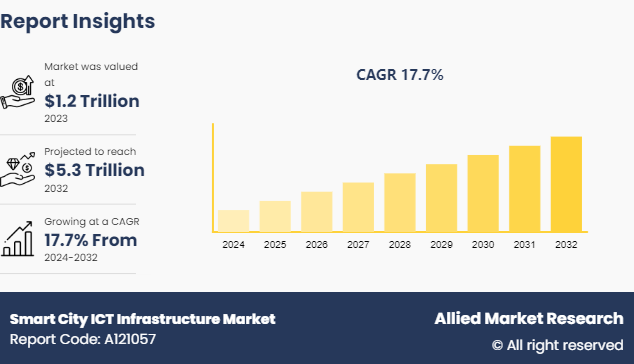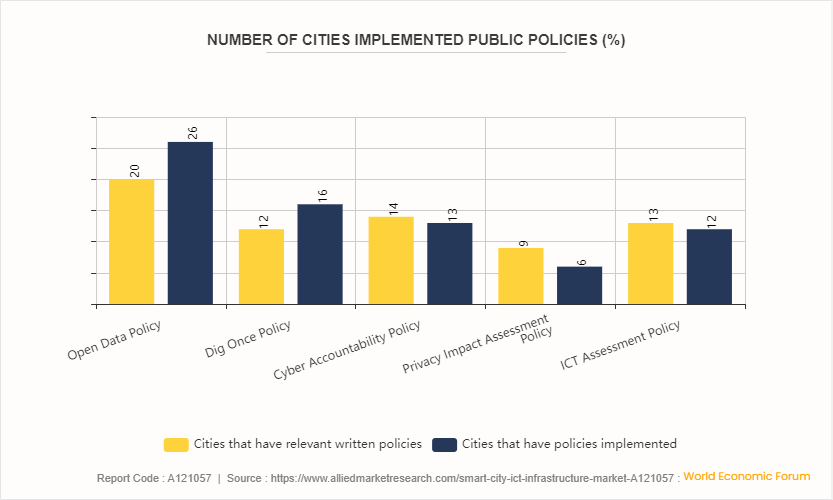Smart City ICT Infrastructure Market Research, 2032
The global smart city ICT infrastructure market size was valued at $1.2 trillion in 2023, and is projected to reach $5.3 trillion by 2032, growing at a CAGR of 17.7% from 2024 to 2032. Smart city ICT infrastructure solutions include a wide range of technologies such as cloud technology, AI, and IoT that offer the network, software, and data infrastructure required for smart city development. These emerging technologies are integral to building smart city ICT infrastructure. ICT solutions provide the facility that supports transportation, healthcare, education, energy, and utility programs driving smart city development.

Communities across the country use smart city ICT infrastructure industry to improve the quality of services they offer residents. Moreover, IoT is viewed as a global infrastructure for communication technology, the technology that connects humans with every other thing. The IoT devices sometimes have processing capabilities called edge computing. Edge computing ensures that only the most important and relevant information is communicated over the communication network.
Key Takeaways
The smart city ICT infrastructure market study covers 20 countries. The research includes a segment analysis of each country in terms of value ($million) for the projected period 2023-2032.
More than 1, 500 product literatures, industry releases, annual reports, and other such documents of major smart city ICT infrastructure industry participants along with authentic industry journals, trade associations' releases, and government websites have been reviewed for generating high-value industry insights.
The study integrated high-quality data, professional opinions and analysis, and critical independent perspectives. The research approach is intended to provide a balanced view of global markets and to assist stakeholders in making educated decisions to achieve their most ambitious growth objectives.
Key market dynamics
The global smart city ICT infrastructure market growth has grown due to several factors such as urbanization in several countries, government regulations & initiatives, and increase in the adoption of digital solutions. However, the lack of a skilled workforce and indistinct regulatory clarity act as restraints for the smart city ICT infrastructure market. In addition, the surge in demand for IoT solutions and the integration of smart devices into a variety of industries are expected to provide ample opportunities for market growth during the smart city ICT infrastructure market forecast period.
The government initiatives and spending have given much more significance to platform providers than standalone smart solutions due to the scalability and integration of other smart solutions. Moreover, smart city platforms perform various functions, such as analytics, remote asset monitoring, performance management, decision support, or presentation components. Most technologically advanced cities use the IoT platform to monitor city infrastructure, manage traffic flows & parking to water and air quality, and use the resulting smart data to tackle longer-term planning decisions around environmental sustainability.
Public Policy of Global Smart Cities ICT Infrastructure Market
Public policies impact the landscape of smart city ICT infrastructure market?by providing the legal framework and incentives essential for sustainable growth. These policies include a wide range of efforts, from promoting innovation and competition to protecting data security and privacy. Governments worldwide have implemented strategies to promote the deployment of advanced technologies in urban areas, such as 5G networks, Internet of Things (IoT) devices, and sensor networks. According to the article published by the World Economic Forum, most cities have not adopted and implemented the foundational policies they need. Out of 36 Pioneer Cities, only two have relevant written guidelines in place for all five policies, and only one has successfully implemented all five.
FIGURE 1: NUMBER OF CITIES IMPLEMENTED PUBLIC POLICIES (%)

Market Segmentation
The smart city ICT infrastructure market size is segmented into type, application, and region. On the basis of type, the market is divided into smart grid, smart building, smart water network, smart healthcare, smart education, smart security, and smart transport. On the basis of application, the market is bifurcated into communications, transportation, express, government, education & others. Region wise, the market is analyzed across North America, Europe, Asia-Pacific, Latin America, and Middle East and Africa.
Regional/Country Market Outlook
Smart city innovations in the U.S. have gained momentum, driven by a combination of technological advancements, government initiatives, and private sector investments. Cities across the country have embraced various innovative solutions to enhance urban living, improve sustainability, and increase efficiency. Moreover, the UK is pioneering the development of smart energy grids and renewable energy initiatives, such as smart meters and community solar projects, to reduce carbon emissions and enhance energy efficiency.
In April 2023, the U.S. Department of Agriculture (USDA) raised $46 million in funding for the Sustainable Agriculture Research and Education (SARE) program. It provides grants that are competitive and educational initiatives to promote farmer-driven innovation to advance climate-smart practices.
In December 2022, the Indian government partnered with Austin University and invested $42 million in funding for smart city projects, which also aimed to change the education system in India.
Industry Trends:
In April 2024, the city of Delray Beach in Florida developed smart parking technology from a new partnership between One Parking, Parking Logix, and eleven-x. Under the project, the companies are expected to use Parking Logix's OpenSpace technology and eleven-x's eXactpark system to digitize 16 surface lots and 1, 200 on-street parking spaces.
In December 2023, a “Smarter Together Testbed” document was developed with citizen input with a focus on five priorities: access to transportation, enhanced communication, public safety, upgraded infrastructure, and environmental resilience. Projects under consideration include a mobile app for citizens to access public services, testing drones to target locations in emergencies, and piloting a smart sewer network with sensors to detect water quality.
Competitive Landscape
The major players operating in the smart city ICT infrastructure market include Microsoft Corporation, IBM Corporation, Oracle Corporation, Cisco Systems, Inc., NTT Communications, ABB, Hitachi, Siemens, Ericsson, and Verizon Communications.
Recent Key Strategies and Developments
In February 2024, NEC Corporation launched enhanced technology solutions as part of the Global Smart City Suite that includes NEC Mi-Command (Integrated Command and Control Centre) , NEC Mi-City (Citizen Engagement Portal) , NEC Mi-Eye (Intelligent Video Analytics) , and NEC Mi-WareSync (Warehouse Management System) .
In February 2024, BT launched its NB-IoT network to support the growth of UK smart cities and industries. The network, which boasts coverage of 97% of the UK population, leverages EE’s mobile network infrastructure.
In August 2023, NEC Corporation launched the latest smart city project in Tirupati, India, for Tirupati Smart City Corporation Limited. The ICT solutions, including integrated services and a unified command and control center, will facilitate real-time data collection and analysis and two-way communications.
Key Sources Referred
Department for Business Innovation & Skills
World Economic Forum
Technology.org
Harvard Business Review
UNICEF
Organization for Economic Co-operation and Development
Key Benefits for Stakeholders
This report provides a quantitative analysis of the smart city ICT infrastructure Market segments, current trends, estimations, and dynamics of the smart city ICT infrastructure market analysis from 2023 to 2032 to identify the prevailing smart city ICT infrastructure market opportunities.
Market research is offered along with information related to key drivers, restraints, and opportunities.
Porter's five forces analysis highlights the potency of buyers and suppliers to enable stakeholders to make profit-oriented business decisions and strengthen their supplier-buyer network.
In-depth analysis of the smart city ICT infrastructure market share segmentation assists to determine the prevailing market opportunities.
Major countries in each region are mapped according to their revenue contribution to the global smart city ICT infrastructure Market Statistics.
Market player positioning facilitates benchmarking and provides a clear understanding of the present position of the market players.
The report includes the analysis of the regional as well as global smart city ICT infrastructure market trends, key players, market segments, application areas, and market growth strategies.
Smart City ICT Infrastructure Market Report Highlights
| Aspects | Details |
| Market Size By 2032 | USD 5.3 Trillion |
| Growth Rate | CAGR of 17.7% |
| Forecast period | 2024 - 2032 |
| Report Pages | 350 |
| By Type |
|
| By Application |
|
| By Region |
|
| Key Market Players | Verizon Communications, Oracle Corporation, IBM Corporation, NTT Communications, Hitachi, Siemens, Microsoft Corporation, Ericsson, ABB, Cisco Systems, Inc. |
Upcoming trends in the Smart City ICT Infrastructure Market globally include the increasing integration of 5G technology, which will enhance connectivity and enable real-time data processing for smart city applications.
The communication is the leading application of Smart City ICT Infrastructure Market.
North America is the largest regional market for Smart City ICT Infrastructure.
$5.3 Trillion is the estimated industry size of Smart City ICT Infrastructure.
Microsoft Corporation, IBM Corporation, Oracle Corporation, Cisco Systems, Inc., NTT Communications, ABB, Hitachi, Siemens, Ericsson, and Verizon Communications are the top companies to hold the market share in Smart City ICT Infrastructure.
Loading Table Of Content...



